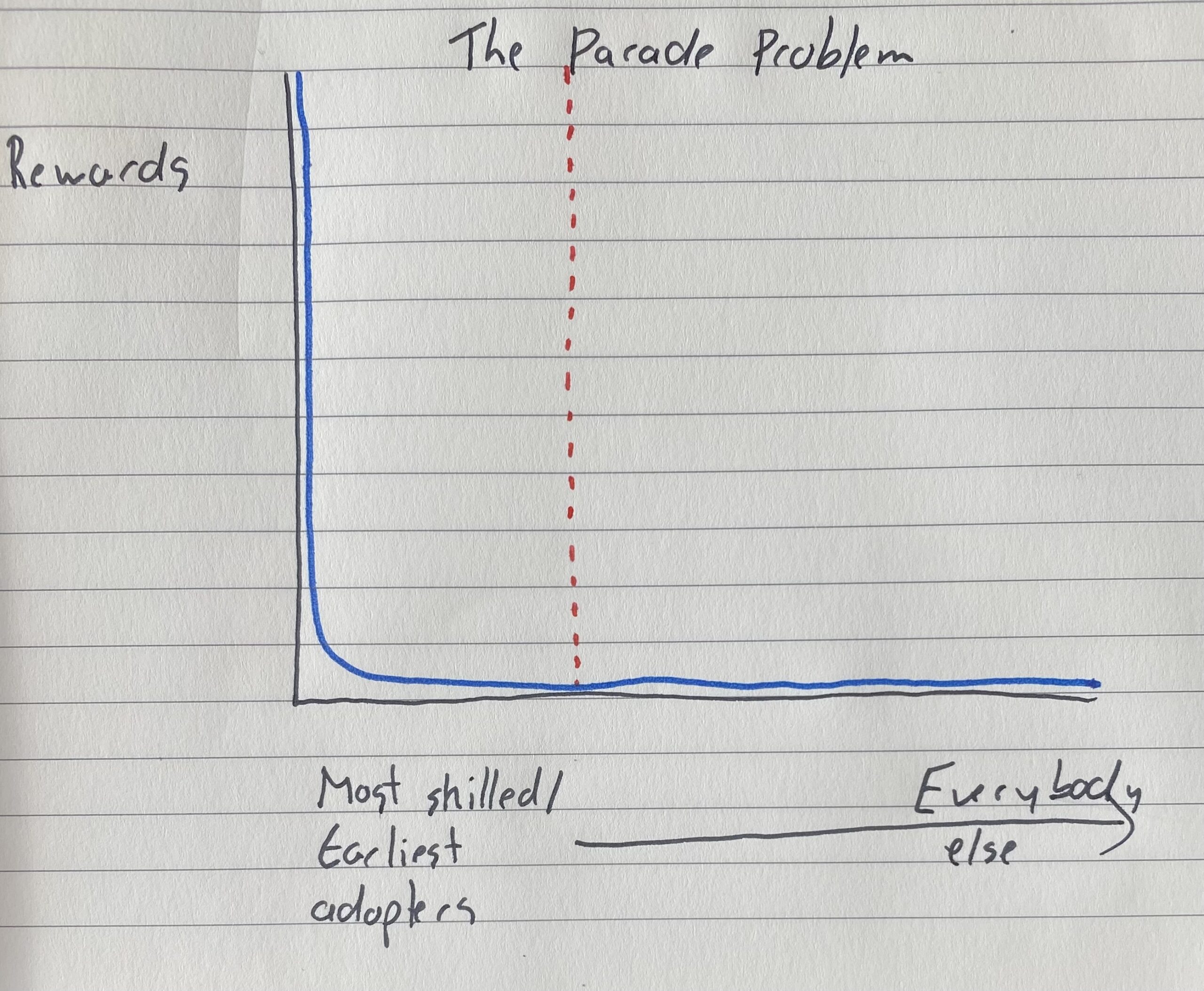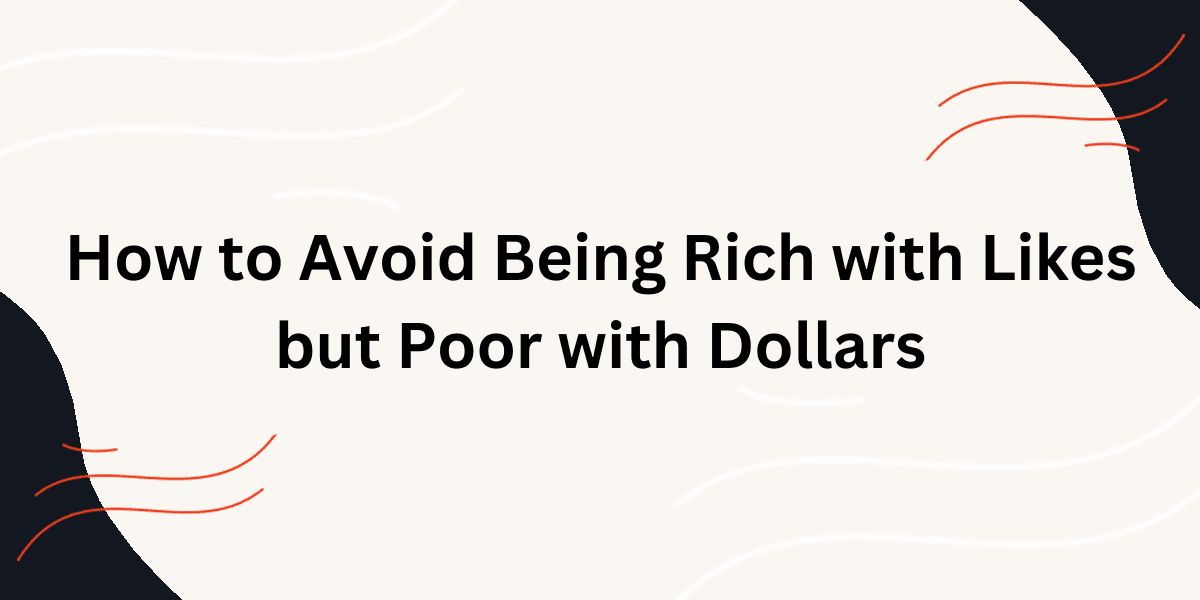Jessica was a struggling online coach with only 6 paying clients.
“My issues are marketing and sales. I need a social media manager, more professional photos of myself, and more time.” She said.
She had 20,600 followers on Instagram when I got her message. That’s enough people to fill Madison Square Garden.
If we assume that her 6 clients came directly from social media, her conversion rate is 0.029%, or 1 client for every 3,433 followers.
Adding free followers isn’t Jessica’s issue; getting paying clients is. Despite prevailing wisdom, they aren’t the same thing.
Jessica's rich with likes but poor with dollars.
--
The Underpants Gnomes Problem
There’s an episode of South Park where a company of gnomes steal underwear. When asked why, they lay out their master plan:
Phase 1: Steal underpants
Phase 2: ???
Phase 3: Profit
Now this might surprise you, but I’m not an experienced boxer brief thief. Still, it’s obvious even to my no-underpants-stealing-self that the above plan is missing something.
The gnomes don’t know how stealing underpants leads to profit. They just started doing it one day for reasons they cannot even remember. Over time, it became habitual.
You’d think at one point a wise gnome would stand up and say,
“Yo gnomeys, we’ve gotta lotta underpants but no profit. Maybe takin’ tighty-whitey’s ain’t good business after all.”
But they don’t because, by this point, the gnomes are so used to dutifully collecting underpants that it’s all that they know.
The Underpants Gnomes Problem states that a lot of people are working hard at the ‘win the internet’ game. By all accounts they’re good at stealing underwear, uhhh, I mean creating content. Many of these same people are tired, frustrated, and confused by a lack of tangible business results.
Doing the wrong thing well is worse than doing the right thing badly.
--
How Jeff Retired his Wife Without Content
When Jeff Steinberg joined the Online Trainer Mentorship, his problem wasn’t making sales; it was attracting enough people to sell to.
Once they were in his free private community, converting them into clients for the Fit Parent Project was straightforward. His problem was that his content wasn't getting attention, and so nobody was joining his community.
What he learned the hard way is that you’re not competing with other coaches on Instagram for attention; you’re competing with full-time influencers and entertainers.
Building a business and becoming an online entertainer are different games people play––neither’s better or worse but problems arise when you conflate the two––playing by the rules of one and desiring the rewards of the other.
Producing ongoing content is exhausting. On top of running a business it’s often too much.
If you enjoy content creation obviously don’t stop doing it. Most don’t. Most people tell me it’s a constant source of anxiety, frustration, and burn-out but they don’t know any other way.
--
Imagine you’re in Scottsdale Arizona for the annual Parada Del Sol.
30,000 people line the streets. It’s packed; nobody can see. So, one person stands on his tip-toes. For a few seconds, it works and he has a good view.
Then everyone else stands on their tip-toes. What happens next, according to Warren Buffet, is that “your view doesn’t improve, but your legs begin to hurt.”
Every time tech presents a new way to share information, collect data, advertise, create content, or market in any way, it seems like an immediate winner. By standard measures it’s often better than what you were doing before: a more scalable way to reach people, an easier way to entertain, a new filter to be more attractive, or a better algorithm. The list goes on.
The problem isn’t that it doesn’t work; it’s that it works the same for everybody.
Viewed individually, the trendy thing right now often makes sense to use. Viewed accurately as a collective, everybody’s use neutralizes everybody else’s.
The more people there are playing the same game, the harder it is for anybody to win.
What initially looks like an advantage unfortunately results in us all working more, benefitting less, and burning out in an endless cycle of one-upmanship.
- It’s true that social media is an incredible way for you to reach people; me too.
- It’s also true that technology allows you to precisely target potential customers with advertisements; me too.
- And, yes, it’s true that artificial intelligence is a fantastic way for you to create huge amounts of content; me too.
For the earliest adopters and the most skilled, the rewards are huge. However, democratization of technology results in what can only be compared to a developing country’s economy: A few super-rich elites, no middle class, and the majority of the population working hard, yet poor, hungry, and hopeless.

The Parade Problem demonstrates what happens whenever tech presents a new way to share information, collect data, advertise, create content, or market in any way. Viewed accurately as a collective, everybody’s use neutralizes everybody else’s. For the earliest adopters and the most skilled, the rewards are huge. For everybody else, rewards are minimal.
There’s currently 56 million posts with the hashtag #personaltrainer on Instagram. Unsurprisingly, the solution to getting bookings is not to somehow outdo them all when you produce #personaltrainer post 56,000,001.
Marketing to humans has become so (in)human.
Counterintuitively, what appears to be improved scalability, production quality, and reach results in increased competition and commoditization. If you can do it, so can everybody else. With every new tool we have to use or we’ll miss out, the problem gets worse.
What Jeff realized is that if everybody’s standing on tip-toes at a parade the secret to success isn’t to join them, it’s to find your own parade.
That, or join somebody else’s parade who has already found a good seat.
--
Solo Mompreneurs have had kids, felt something was missing, and built it themselves. In many cases, these women have not only built great products but are also inspirational and, as a result, have gained media attention and a following online.
Instead of trying to attract parents through his own content, Jeff found Mompreneurs with at least 10,000 followers. These women were already selling healthy products at premium prices to Jeff’s target market.
People who buy premium health products, buy lots. And people who don't, don't.
Instead of building your own audience from scratch, find people who have already built similar audiences.
Rhowena (Rhow) owned and operated Healing Mama Co. They made pre and postpartum kits for expectant mothers. Rhow’s good at social media. As a result, her Instagram page had 22,000+ followers.
At the time, an Ultimate Labor & Postpartum Hospital Bag from Healing Mama Co. cost $288.88. Jeff bought a bag from Rhow and did a collaborative giveaway with her on Instagram. In order to enter, people had to join Jeff’s Fit Parent Project online community (which is where the winner got announced.)
Jeff’s minimum coaching package costs $2,000. He could run 7 promotions with Rhow and get one client to break even. Not only that, he can scale by running promotions with multiple pages at once all feeding his free community.
--
Using Instagram for conversion, not attention
Most people view social media as a tool for generating attention. And it is. But you’ve got to be all-in on content creation––a game most trainers I speak to don’t want to play.
Still, no matter how a customer hears about you, they’ll often search you online.
It’s important to have a presence on social media but you don’t have to be stuck in an endless content creation cycle. Instead, build out your account like it’s a sales page. It’s job isn’t to attract attention; it’s to convert attention into business that gets attracted elsewhere.
- 2-3 staple content pieces focusing on biggest questions / concerns.
- Case studies / testimonials.
- A clear call to action how to buy from you.
When you build a system like this you don't need to worry about ongoing engagement.
Use your page to provide updates, list promotions, showcase reviews, case studies, and testimonials. Then, focus your attention on positive sum promotions done with others who like creating content.
To be clear, what I just described isn't the only way or even the best way to grow a great coaching business.
But the best way doesn't much matter. What matters is that you find the right way for you that works good enough.
Jeff added over 100 people into his free community from the promotion with Rhow. He welcomed each one when they joined and transitioned them where appropriate into high-converting yet respectful consultative sales conversations.
Within six months, Jeff's business grew to the point where his wife quit her unfulfilling job after her maternity leave to join him as an assistant coach. And Rhowena, she’s happy too. She made a sale and got to do a cool giveaway.
My goal in sharing Jeff's story was to show you that there's another way to use social media to get clients if you're the type of person who doesn't love content creation.
-Jon
--
P.S. If you found this article useful, please consider clicking here to Tweet it.










